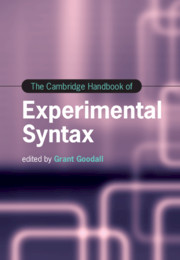Book contents
- The Cambridge Handbook of Experimental Syntax
- The Cambridge Handbook of Experimental Syntax
- Copyright page
- Contents
- Figures
- Tables
- Contributors
- Introduction
- Part I General Issues in Acceptability Experiments
- Part II Experimental Studies of Specific Phenomena
- Part III Experimental Studies of Specific Populations and Language Families
- Part IV Experimental Syntax beyond Acceptability
- 22 Theories All the Way Down
- 23 Eye-Tracking and Self-Paced Reading
- 24 Nothing Entirely New under the Sun: ERP Responses to Manipulations of Syntax
- 25 Corpus Studies of Syntax
- 26 Syntax and Speaking
- 27 Neuroimaging
- Index
- References
22 - Theories All the Way Down
Remarks on “Theoretical” and “Experimental” Linguistics
from Part IV - Experimental Syntax beyond Acceptability
Published online by Cambridge University Press: 16 December 2021
- The Cambridge Handbook of Experimental Syntax
- The Cambridge Handbook of Experimental Syntax
- Copyright page
- Contents
- Figures
- Tables
- Contributors
- Introduction
- Part I General Issues in Acceptability Experiments
- Part II Experimental Studies of Specific Phenomena
- Part III Experimental Studies of Specific Populations and Language Families
- Part IV Experimental Syntax beyond Acceptability
- 22 Theories All the Way Down
- 23 Eye-Tracking and Self-Paced Reading
- 24 Nothing Entirely New under the Sun: ERP Responses to Manipulations of Syntax
- 25 Corpus Studies of Syntax
- 26 Syntax and Speaking
- 27 Neuroimaging
- Index
- References
Summary
It is common in linguistics to contrast “theoretical” and “experimental” research. Researchers who pursue experimental research are often asked about the theoretical consequences of their work. Such questions generally equate “theoretical” with theories at a specific high level of abstraction, guided by the questions of traditional linguistic theory. These theories focus on the structural representation of sentences in terms of discrete units, without regard to order, time, finer-grained memory encoding, or the neural circuitry that supports linguistic computation. But there is little need for the high-level descriptions to have privileged status. There are interesting theoretical questions at all levels of analysis. A common experience is that we embark on a project guided by its apparent relevance to high-level theoretical debates. And then we discover new theoretical questions at lower levels of analysis that we had not been aware of previously. We illustrate this using examples from many different lines of experimental research.
- Type
- Chapter
- Information
- The Cambridge Handbook of Experimental Syntax , pp. 587 - 616Publisher: Cambridge University PressPrint publication year: 2021
References
- 3
- Cited by

